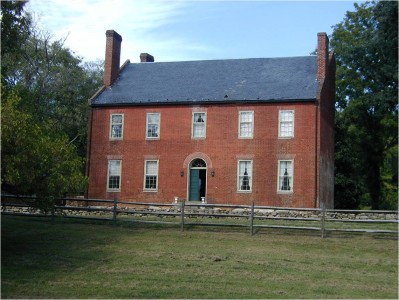Moncure Conway House
The stately Federal-period Moncure Conway House in Falmouth is one of Stafford’s historic treasures. The home was associated earlier with the Vass and Beale families. It was the boyhood home of Moncure Daniel Conway, the South’s most prominent abolitionist. During the Civil War it was used as a Union hospital.
The current owners, Norman and Lenetta Schools, have made heroic efforts to restore the house to historical prominence. They have achieved recognition for their efforts. Yearly, they allow the house and grounds to be used for a wide variety of historic activities, including Stafford’s annual “Yankees in Falmouth…and some Confederates too!”
The building is on the National Register of Historic Places. ( A Stafford elementary school is named for Moncure Conway.)
In Summer 1862, the presence of the Union Army in Falmouth gave Dunmore and Eliza Gwinn as well as other people enslaved by Walker Peyton and Margaret Conway, the opportunity to self-emancipate. Their son, Moncure Conway, became a fervent abolitionist who traveled back to his Falmouth home and helped the Gwinns and others once enslaved by his family to travel to Yellow Springs, Ohio, where they founded a community known as the Conway Colony.
Moncure Daniel Conway was born in Stafford County in 1832 to a prominent, slave-owning family. His father, Walker Peyton Conway, was a county magistrate and his mother, Margaret Stone Daniel, was a descendant of a signer of the Declaration of Independence. Rebelling from his family, Moncure Conway embraced abolitionism in the early 1850s and was forced to leave Virginia after rumors surfaced about his connection to Anthony Burns, the enslaved Stafford man whose escape and subsequent trial is told at this trail’s Union Church and Hartwood stops. He became the minister of the First Unitarian Church in Cincinnati, Ohio, in 1856. Conway traveled to Washington, DC, in 1862 when he heard that the people his family had enslaved in 1862 may have still been in Confederate territory. He found them in the Georgetown area of DC. when the Union army occupied most of the county to help thirty-one people once owned by his father take a train to Yellow Spring, Ohio.
When Eliza and Dunmore Gwinn were still enslaved house servants for the Conway family, they took advantage of the arrival of the Union Army to move to Georgetown. where they ran a candy store. Given the uncertainties of their status as freed people during the war, they and other former slaves of the Conways agreed with Moncure Conway’s plan to take a train to Ohio. Once in Yellow Spring, the Gwinns helped found the Conway Colony. There they lived on five acres of land and were among the founders of the First Anti-Slavery Baptist Church, now known as First Baptist Church. Descendants of the Conway Colony’s founders still live in the Yellow Springs area to this day.


